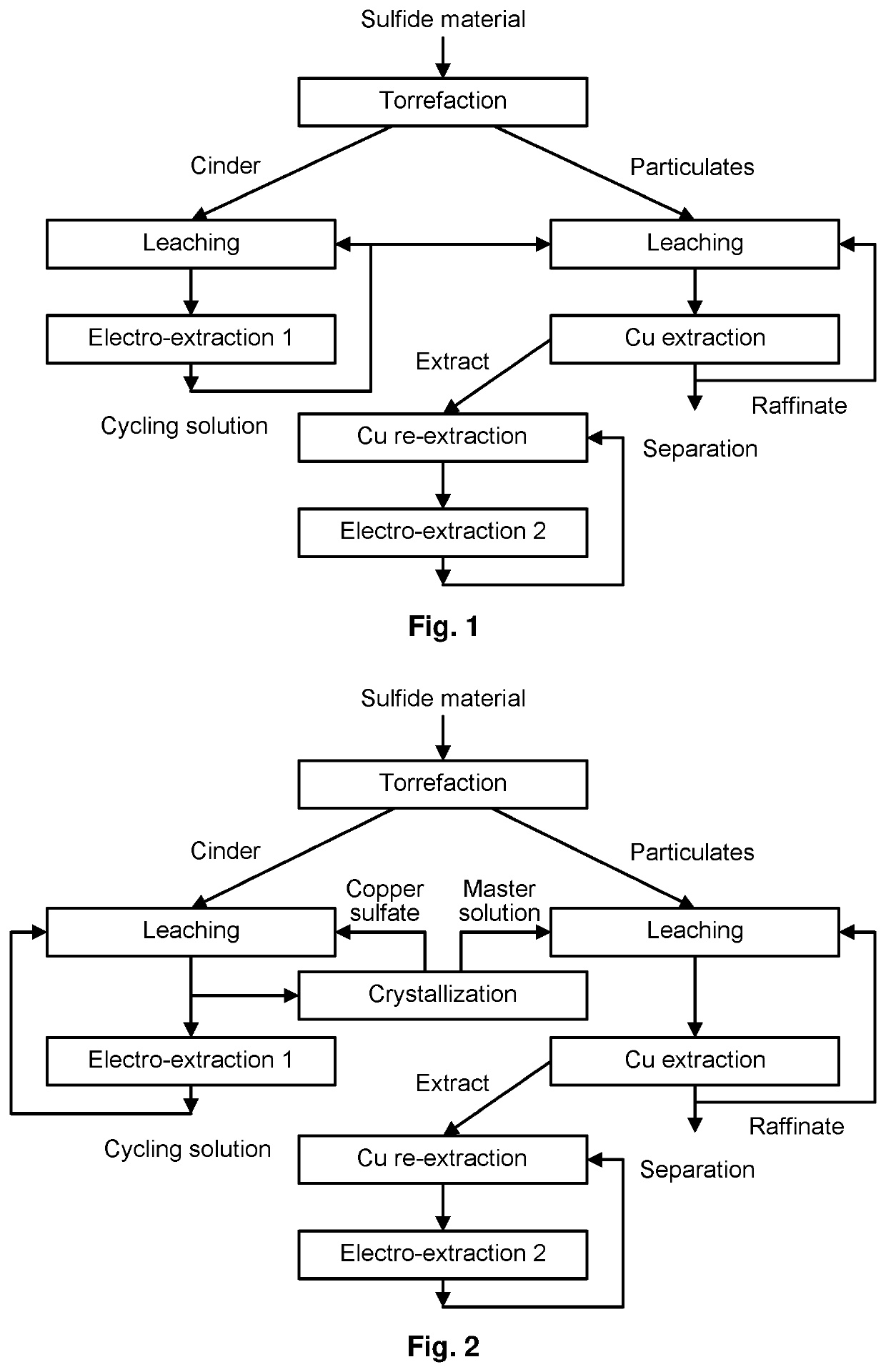Method for processing copper and nickel sulfide materials
a nickel sulfide and material processing technology, applied in the direction of process efficiency improvement, etc., can solve the problems of high operation cost, corrosion in torrefaction gas processing system, method does not disclose the specificities of copper production process, etc., to improve the performance characteristics of copper and nickel sulfide material processing, increase direct extraction of copper, and reduce the loss of copper and other valuable components
- Summary
- Abstract
- Description
- Claims
- Application Information
AI Technical Summary
Benefits of technology
Problems solved by technology
Method used
Image
Examples
example 1
ation of the Closest Prior Art Method
[0040]Copper concentrate from flotation separation of converter matte, which contains, in %: Cu—70.7; Ni—3.9; Fe—3.9; S—21.0, is torrefied in a fluidized layer (FL) furnace at a fluidized material layer temperature of 870°−930° C. until sulfur residue content in the cinder is 0.1%. After filtering out particulates, torrefaction gases are forwarded into a sulfur acid production process. Torrefaction results in cinder with the following composition, %: Cu—71.3; Ni—3.9; Fe—3.9; and fine particulates enriched up to 2.0% sulfur, with the following composition, %: Cu—68.7; Ni—4.4; Fe—4.4. Fine particulates output is 15.5% of cinder output.
[0041]Particulates and cinder are leached together at a temperature of 70°−80° C. in a circulating solution after copper electro-extraction, with the following composition, g / l: Cu—35; H2SO4—120. Leaching residue is condensed and sent to water flushing and flotation. After postfiltration, cinder leaching solution, hav...
example 2
ation of the Inventive Method
[0045]Copper concentrate from flotation separation of converter matte, which contains, in %: Cu—70.7; Ni—3.9; Fe—3.9; S—21.0, is torrefied in a fluidized layer (FL) furnace at a fluidized material layer temperature of 870°−930° C. until sulfur residue content in the cinder is 0.1%. After filtering out particulates, torrefaction gases are forwarded into a sulfur acid production process. Torrefaction results in cinder with the following composition, %: Cu—71.3; Ni—3.9; Fe—3.9; and fine particulates enriched up to 2.0% sulfur, with the following composition, %: Cu—68.7; Ni—4.4; Fe—4.4. Fine particulates output is 15.5% of cinder output.
[0046]Thus, the initial material and conditions of its torrefaction, as well as amount and quality of cinder and particulates, are the same as in Example 1.
[0047]Cinder is leached at a temperature of 70°−80° C. in a circulating solution from cinder processing line, which is the solution from copper electro-extraction 1, with ...
example 3
ation of the Inventive Method
[0052]In an optimal embodiment, the claimed method further includes boiling down and crystallization of copper sulfate from a portion of cinder leaching solutions. In this case, it is not the portion of electrolyte recovered from the copper electro-extraction 1 baths, but a master solution from copper sulfate crystallization that is sent to the particulates leaching.
[0053]The initial material and conditions of its torrefaction, as well as amount and quality of cinder and particulates, are the same as in the Example 1.
[0054]The cinder is leached at a temperature of 70°−80° C. in a circulating solution from the cinder processing line, which is the solution from copper electro-extraction 1, which has the following composition, g / l: Cu—35; H2SO4—120. Residue from cinder leaching is condensed and forwarded to water flushing and flotation together with residue from particulates leaching. After postfiltration, bulk of the cinder leaching solution, which has the...
PUM
| Property | Measurement | Unit |
|---|---|---|
| concentration | aaaaa | aaaaa |
| temperature | aaaaa | aaaaa |
| concentration | aaaaa | aaaaa |
Abstract
Description
Claims
Application Information
 Login to View More
Login to View More - R&D Engineer
- R&D Manager
- IP Professional
- Industry Leading Data Capabilities
- Powerful AI technology
- Patent DNA Extraction
Browse by: Latest US Patents, China's latest patents, Technical Efficacy Thesaurus, Application Domain, Technology Topic, Popular Technical Reports.
© 2024 PatSnap. All rights reserved.Legal|Privacy policy|Modern Slavery Act Transparency Statement|Sitemap|About US| Contact US: help@patsnap.com








